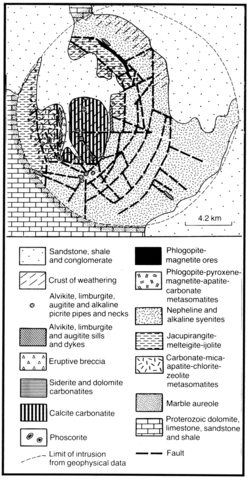stripes
The Tomtor complex is located on the Udzhinsky rise, that is composed of tuffaceous and carbonate deposits of Upper Proterozoic age. The complex is covered by Quaternary sediments with a thickness of 10-140 m, and was discovered as the result of geophysical work; it has been investigated by drilling. It is circular in form with a diameter of 16 km; the outer contacts are vertical. The principal rock types are jacupirangite-ijolite, nepheline and peralkaline syenites and a carbonatite series, which includes apatite-magnetite rocks - phoscorites. In the central part there is a stock-like body of calcite carbonatites towards the periphery of which the carbonatites change into a zone of breccia with a carbonatitic cement. Dykes of alnoite, limburgite, augitite and picrite are concentrated in this zone. To the west of the carbonatites there is a block of Upper Proterozoic rocks which have been intensively metasomatised, and to the east and north of the carbonatites there is a zone of alkaline-ultrabasic rocks which includes nepheline pyroxenites, melteigites, ijolites and associated magnetite ores. All these rocks are characterised by heterogeneous textures and structures and are intensively metasomatised and phlogopitised. The peripheral zone of the Tomtor complex consists of nepheline and peralkaline syenites which are cut by numerous dykes, necks and pipes of alkaline ultrabasic rocks (alnoite, picrite and alvikite). Overlying the massif there is a mantle of weathered rocks with a thickness of 50-200 m which comprises kaolinitic, francolitic and carbonatitic facies which are rich in iron oxides. The geochemistry and origin of the complex are discussed by Kravchenko et al. (1993).
ENTIN, A., ZAITSEV, A.I., NENASHEV, N.I., VASILENKO, V.B., ORLOV, A.N., TIAN, O.A., OLKHOVOK, Yu.A., OLSHTYNSKII, S.P. and TOLSTOV, A.V. 1990. On the sequence of geological events involved in the intrusion of the Tomtor massif of ultrabasic alkaline rocks and carbonatites (North-western Yakutia). Geologiya i Geofizika. Novosibirsk, Part 12: 42-51.
ERLIKH, E.N. and ZAGRUSINA, I.A. 1981. Geological aspects of the geochronology of the north-eastern part of the Siberian Platform. Izvestiya Akademia Nauk SSSR, Seriya Geologiya, N.G. 8: 5-13.
*KRAVCHENKO, S.M., BELYAKOV, A.Yu., KUBYSHEV, A.I. and TOLSTOV, A.V. 1990. Scandium-rare earth-yttrium-niobium ores - a new economic resource. International Geology Review, 32: 280-4.
*KRAVCHENKO, S.M., BELYAKOV, A.Yu. and POKROVSKIY, B.G. 1993. Geochemistry and origin of the Tomtor massif in the North Siberian Platform. Geochemistry International, 30: 20-36.
PORSHNEV, G.I. and STEPANOV, L.L. 1980. Geological structure and phosphate-bearing rocks of the Tomtor massif (north-western Yakutia). In Alkaline magmatism and apatite-bearing rocks of north Siberia. 84-100. Nauchno-Issledovatel'skogo Instituta Geologii Arktiki, Leningrad.
PORSHNEV, G.I. and STEPANOV, L.L. 1981. Geology and mineralogy of the Ud'in Province (north-western Yakut ASSR). Sovetskaya Geologiya. Moskva, 12: 103-6.

